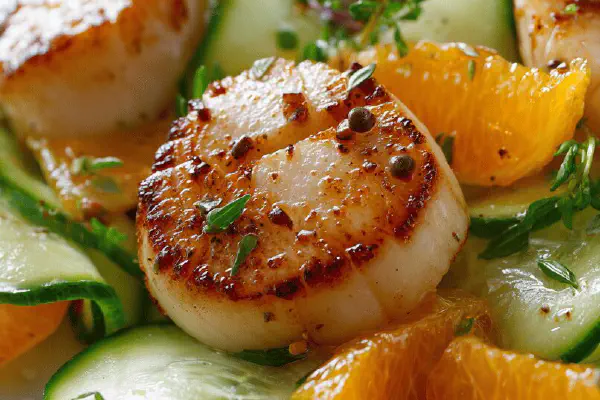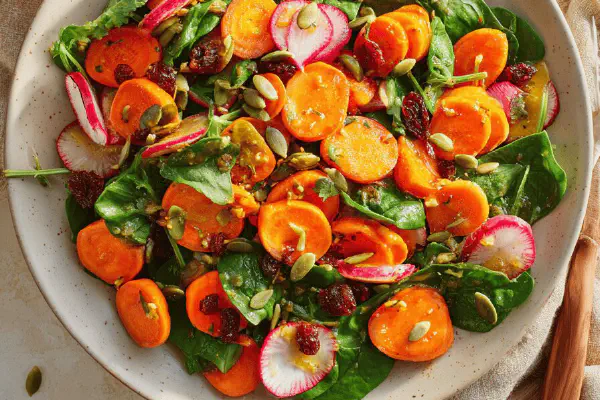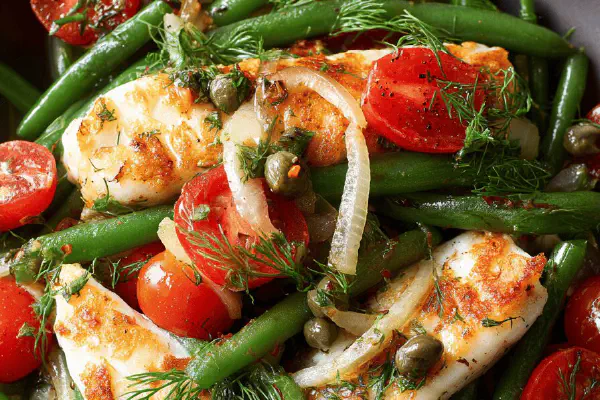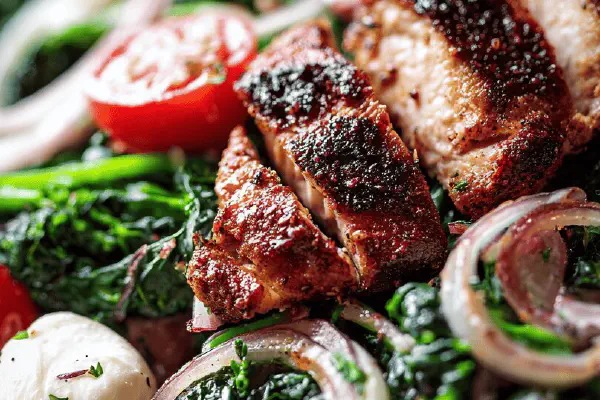Scallop Orange Salad Tulips

By Emma
Certified Culinary Professional
Ingredients
Dressing
- 40 ml white wine vinegar (about 2½ tablespoons)
- 20 ml freshly squeezed lemon juice (approx 1½ tablespoons)
- 30 ml extra virgin olive oil (2 tablespoons)
- 5 ml runny honey (1 teaspoon)
- 5 ml Dijon mustard (1 teaspoon)
- Season with salt and freshly cracked black pepper
Salad
- 5 large scallops, patted very dry (about 250 g)
- 1 small English cucumber, peeled, deseeded, thinly sliced
- Segments from 1 large orange
- 4 edible tulip petals, cleaned gently (or small endive leaves as a backup)
- 15 ml finely chopped fresh thyme leaves
- Splash of olive oil for cooking
About the ingredients
Method
Dressing
- Whisk vinegar, lemon juice, honey, and mustard briskly in a small bowl until emulsified.
- Slowly drizzle olive oil while whisking constantly to combine fully.
- Season cautiously with salt and pepper. Refrigerate briefly if needed.
Salad
- Heat a nonstick skillet over medium-high heat until shimmering but not smoking.
- Add a small splash of olive oil; swirl to coat pan evenly. Scallops should sizzle immediately.
- Place scallops in hot pan, one by one, without crowding. Sear untouched for around 90 seconds till golden and caramelized on the underside.
- Flip carefully; cook for another 60 seconds. Look for opaque edges and slightly springy centers. Overcooking turns scallops tough – better slightly under than over.
- Remove scallops immediately to a plate; let rest 5 minutes to firm up and cool to room temp.
- Slice scallops into thin rounds or medallions – easier to eat and less dominating bite.
- In a medium bowl, gently fold sliced scallops, cucumber, and orange segments.
- Pour in the dressing gradually while tossing to coat. Taste and add salt or lemon juice if needed.
- Set tulip petals upright on serving plates or inside small glasses for stability.
- Divide salad evenly into petals, letting colors peek out. Sprinkle thyme over top.
- Serve promptly. Tulips wilt if salad sits too long; best fresh.
Notes
- If scallops aren’t fresh or not available, dry-packed shrimp or bay scallops can be a substitute but adjust cooking times accordingly.
- Orange segments can be replaced with grapefruit for a sharper bitterness or Meyer lemon for sweetness.
- Thyme can be swapped with chives or even finely minced basil for herbal variation.
- Keep cucumber slices very thin for added crunch without overpowering delicate seafood.
- Tulip petals need to be unblemished and washed carefully with cold water; use salad tongs or chopsticks to avoid bruising.
- Don’t skip resting scallops after searing – this keeps juices locked in and avoids rubbery texture.
- Serve immediately for crisp petal shells and fresh flavors; leftovers tend to lose vitality and texture.
- Avoid excess dressing; scallops and fruit can get soggy quickly.
- For more zing, add a pinch of grated fresh ginger or a few drops of lemongrass oil to dressing.
- Watch the pan heat carefully – too hot blackens scallops, too cool results in pale, lackluster sear.
Cooking tips
Chef's notes
- 💡 Dry scallops well or they steam not sear. Wet scallops? Rubber texture guaranteed. Use paper towels, press hard. Pan must be hot but not smoking. Listen for sizzle—that hiss means caramel in progress. Too cool pan? No crust, pale scallops with no snap. One flip only, poking kills juices and crust formation.
- 💡 Tulip petals need gentle hands. Cold water rinse, no bruising or tearing. Dry them slightly. Edible but fragile, so fill last minute before serving. Wilt happens fast if salad sits. Backup leaves like endive or small butter lettuce work but texture and look shift. Avoid big leafy greens or petals get overwhelmed.
- 💡 Dressing balance is key. White wine vinegar plus lemon juice; sharp acidity anchors honey and Dijon mustard sweetness. Whisk honey and mustard first, oil drizzled slowly for emulsification. Salt and fresh black pepper finish, add gradually to avoid overpowering. Chill briefly if too sharp but serve near room temp to not dull flavors.
- 💡 Orange segments can swap with grapefruit for extra bitterness or Meyer lemon for more mellow sweetness. Peeling thin and removing membranes ensures no bitterness and clean bite. Thin cucumber slices add crunch but avoid watery or bitter bits by peeling and deseeding carefully. Fresh thyme aromatic but basil or chives shift into different flavor profiles.
- 💡 Rest scallops after sear. Plate uncovered, five minutes minimum to lock texture. Cutting hot scallops leads to mushy bits, wait for warm not piping hot. Slicing medallions thin makes salad less clunky. Fold fruit and cucumber gently, dress last moment to keep crunch. Taste final seasoning—sometimes lemon or salt boost is needed before plating.
Common questions
What if scallops aren’t fresh?
Use dry-packed shrimp or bay scallops. Adjust cooking time—shrimp cook faster. Flavor different but similar texture. Keep pan hot and dry proteins. Overcrowding pan dulls sear. Don’t skip drying first or get rubbery results.
Can I use other edible petals?
Yes. Endive or butter lettuce leaves work as fallback. Endive holds shape but more bitter. Butter lettuce softer and wilt faster. Avoid spinach or kale—they droop and alter taste. Delicate textures better, fragility part of the dish’s appeal.
How to avoid soggy salad?
Dress last minute; excess dressing softens petals and cucumber. Cucumbers peeled and deseeded reduce water release. Scallops rested and dry avoid extra liquid. Keep salad cold to slow wilting but not too cold to mute flavors. Serve quick, tulips lose form if wait too long.
Can dressing be stored?
Yes, separately refrigerated up to 2 days. Oil and acids separate; shake or whisk before use. Avoid mixing dressing with salad early or everything wilts fast. Leftovers best stored without petals. Re-toss just before serving to keep textures bright.



